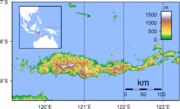Flores
 Topography of Flores |
|
| Geography | |
|---|---|
 |
|
| Location | South East Asia |
| Archipelago | Lesser Sunda Islands |
| Area | 13,540 km²[1] (60th) |
| Highest point | Poco Mandasawu (2,370 m) |
| Country | |
| Province | East Nusa Tenggara |
| Largest city | Maumere |
| Demographics | |
| Population | 1,600,000 (as of 2003) |
| Density | 112/km² people/km2 |
Flores is one of the Lesser Sunda Islands, an island arc with an estimated area of 14,300 km² extending east from the Java island of Indonesia. The population is estimated to be around 1.5 million [2], and the largest town is Maumere.
Flores is located east of Sumbawa and Komodo and west of Lembata and the Alor Archipelago. To the southeast is Timor. To the south, across the Sumba strait, is Sumba and to the north, beyond the Flores Sea, is Sulawesi.
On December 12 1992, an earthquake measuring 7.8 on the Richter scale occurred, killing 2,500 people near the island of Flores.
Contents |
Administration
Flores is part of the East Nusa Tenggara province. The island is split into seven regencies (local government districts); from west to east these are: West Manggarai, Central Manggarai, Ngada, Nagekeo , Ende, Sikka and Flores Timur.
Flora and fauna
The west coast of Flores is one of the few places, aside from the island of Komodo itself, where the Komodo dragon can be found in the wild. The Flores Giant Rat is also endemic to the Island.
In September 2003, at Liang Bua Cave in western Flores, paleoanthropologists discovered small skeletons that they described as a previously unknown hominid species, Homo floresiensis. These are informally named hobbits and appear to have stood about one metre tall. The most complete individual (LB1) is dated as 18000 years old. A description of a new species was published, but this remains disputed by other research that concludes they were afflicted with a growth disorder.[3]
Flores was also a habitat of the extinct Stegodon dwarf elephant until approximately 18,000 years ago. It also was the habitat of species of giant rodents. It is speculated by scientists that limited resources drove the few species that lived upon the island to gigantism and dwarfism. [4]
Culture

There are many languages spoken on the island of Flores, all of them belonging to the Austronesian family. In the centre of the island in the districts of Ngada, Nagekeo, and Ende there is what is variously called the Central Flores Dialect Chain or the Central Flores Linkage. Within this area there are slight linguistic differences in almost every village. At least six separate languages are identifiable. These are from west to east: Ngadha, Nage, Keo, Ende, Lio and Palu'e, which is spoken on the island with the same name of the north coast of Flores. Locals would probably also add So'a and Bajawa to this list, which anthropologists have labeled dialects of Ngadha.
Portuguese traders and missionaries came to Flores in the 16th century, mainly to Larantuka and Sikka. Their influence is still discernible in Sikka's language and culture. In fact, the island's name, Flores, means "flowers" in Portuguese.
Flores is almost entirely Catholic and represents one of the "religious borders" created by the Catholic expansion in the Pacific and the spread of Islam from the west across Indonesia. In other places in Indonesia, such as in the Malukus and Sulawesi, the divide is more rigid and has been the source of bloody sectarian clashes.
Tourism

The most famous tourist attraction in Flores is Kelimutu; three coloured lakes in the district of Ende and close to the town of Moni. These crater lakes are in the caldera of a volcano, and fed by a volcanic gas source, resulting in highly acid water. The coloured lakes change colours on an irregular basis, depending on the oxidation state of the lake (see Pasternack, Keli Mutu Volcanic Lakes), from bright red through green and blue. The latest colours (late 2004) were said to be turquoise, brown and black.
There is good snorkelling and diving on several locations along the north coast of Flores, most notably Maumere and Riung. However, due to the destructive practice of local fishermen using bombs to fish, and locals selling shells to tourists, combined with the after effects of a devastating tsunami in 1992, the reefs have slowly been destroyed.
Labuanbajo (on the western tip of Flores) is a town often used by tourists, from where they can visit Komodo and Rinca. Labuanbajo also attracts scuba divers, as whale sharks inhabit the waters around Labuanbajo.
Tourists can visit Luba and Bena villages to see traditional houses in Flores. Larantuka, on the isle's eastern end, is known for its Holy Week festivals.
In addition to tourism, the main economic activities on Flores are agriculture, fishing and seaweed production. The primary food crops being grown on Flores are rice, maize sweet potato and cassava, while the main cash crops are coffee, coconut, candle nut and cashew. [5] Flores is one of the newest origins for Indonesian coffee. Previously, most Arabica coffee (Coffea arabica) from Flores was blended with other origins. Now, demand is growing for this coffee because of its heavy body and sweet chocolate, floral and woody notes.[6]
Gallery
See also
- Dutch Empire
- Nage tribe
- Portuguese Empire
- Simon Milward
References
- ↑ Monk, K.A.; Fretes, Y., Reksodiharjo-Lilley, G. (1996). The Ecology of Nusa Tenggara and Maluku. Hong Kong: Periplus Editions Ltd.. p. 7. ISBN 962-593-076-0.
- ↑ "Trapping Komodo Dragons for Conservation" National Geographic - 28 Jan 2003
- ↑ "BBC News, Science/Nature: Hobbit cave digs set to restart". Retrieved on 2007-01-30.
- ↑ "Hobbits" Were Pygmy Ancestors, Not New Species, Study Says National Geographic - 21 Aug 2006
- ↑ Indonesian Chamber of Commerce and Industry: [1], Retrieved on 2008-08-08
- ↑ Specialty Coffee Association of Indonesia: [2], Retrieved on 2008-08-08